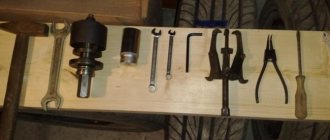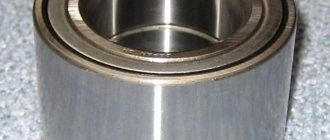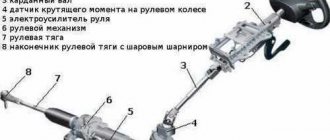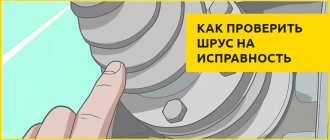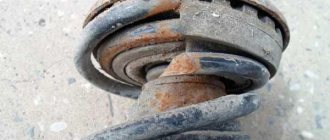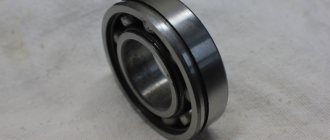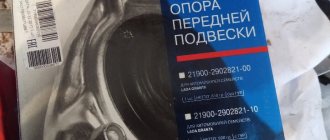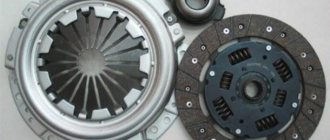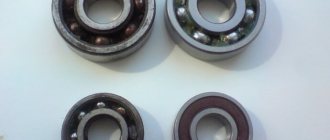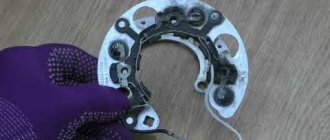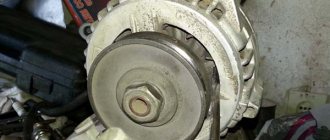Signs and causes of wheel bearing failure
Regardless of the location of the ball bearings, the front or rear wheel bearings, according to diagnostics, do not differ either in the testing methods, or in the characteristic signs of malfunctions, or in the type of wheel drive.
Wheel bearing fault table
| N p/p | Symptoms of a problem | Causes of malfunction | |
| Front | Rear | ||
| 1 | The appearance of extraneous noise (low-frequency hum) in the car interior. | lack of lubrication or incorrect choice, long service life, unqualified replacement, extreme driving, the state of our roads, impacts with potholes. | |
| 2 | When driving, vibration is felt in the steering wheel or brake pedal. | Vibration only in the brake pedal. | Possible wear on the tie rod end, wear on the wheel bearing or brake disc. |
| 3 | The appearance of grease leaks on the protective cap or oil seal. | Excessive lubricant, oil seal destruction. | |
| 4 | Excessive hub heating | Insufficient lubrication, incorrect tightening torque of the hub nut. Possible depressurization of seals. | |
| 5 | Grinding and knocking noise when the suspended wheels rotate. | The ball joint, brake discs, and car suspension parts may wear out. Diagnosis is necessary. | |
| 6 | When changing speed or entering a turn, the nature of the noise changes. | Worn wheel bearings. Other unpleasant noises may change: rattling of the exhaust pipe, gearbox transfer mechanism, tire noise. | |
| 7 | Axial play of suspended wheel | The CV joint or wheel bearings fail, the wheel bolts or wheel nut are insufficiently fastened. | |
| 8 | The ABS warning light is on. | The sensor is faulty, perhaps the magnetic ring is turned the other way, probably the number of teeth on the abs ring does not correspond to the original number for this car model. | |
| 9 | Loss of controllability, the car pulls to the side. | It is possible that the tires are unevenly inflated, the wheel alignment is incorrectly adjusted, or the hub is not pressed onto the axle shaft in a coaxial manner. Drives to the right - the problem is the right wheel, to the left - vice versa. The front wheels need to be checked. | |
It is important to know:
If you haven’t found the source of the unhealthy noise, contact experienced drivers or service station mechanics. Professional diagnostics will not be superfluous.
Causes of failure
To be honest, the bearing is a very durable part of the hub. And to “kill” him you need to try! Most likely, all kinds of racks, rubber bushings and other attached parts will fail, but if you “try” you can also damage this element.
1) Long mileage . No matter how trivial it may sound, a long mileage of a car wears out all the components, and the bearing is no exception. This is the main cause of the malfunction, the rest are secondary. After approximately 70 - 120,000 kilometers, different manufacturers have different ways. You will hear a characteristic crunch. It says that this part needs to be changed.
2) Loss of tightness . The bearing has a little lubricant, which is covered with special casings made of rubber or plastic. If they break, the lubricant comes out and wear becomes much greater. After just a couple of thousand kilometers you can hear a characteristic hum, which indicates a malfunction.
3) Sloppy driving . If you constantly fly into holes at high speeds, this will also wear out this unit a little. Although, as I wrote above, other suspension elements will fail faster.
4) Incorrect pressing . This is a secondary reason; during repairs, the new bearing may be pressed in incorrectly, for example, obliquely. Thus, when driving, it will not stand correctly, which will wear it out quite quickly; after about a couple or three thousand kilometers it will need to be changed again.
5) If you tighten it too much . This happened especially on our domestic cars; the bearing was overtightened during replacement, so it heated up more than usual, which also contributes to a decrease in service life and subsequent breakdown. So you need to take into account the twisting force; it is usually indicated in the instructions.
These are all the main reasons, but as you can see, the last two are the “crooked hands” of the car service. So we only replace them at trusted stations that provide a guarantee on the work. Sometimes it is more profitable to look at official stations.
How to check a wheel bearing while driving
While the car is moving, if there is extraneous noise in the cabin, it becomes a hearing irritant for the driver. Finding the source of noise is sometimes difficult, because many components and parts of a machine can produce sound. Try to accelerate the car. Some tires can create a hum at high speeds, thereby misleading the driver.
On-the-go check video:
You can find out which side the fault is on by maneuvering:
- Turn left, the load on the left axle will decrease, if the sound disappears or weakens, then the problem is on the left side.
- Turn to the right, the load on the left side will increase, a hum will appear, which means the assumption that the fault is on the left side is correct.
- Try varying your speed and alternating turns left and right.
- Listen to how the frequency and tone of the sound changes. It can decrease, increase, and sometimes disappear altogether.
Unbend the car on a flat road, release the gas, and move by inertia. Let the passenger listen to where the hum is coming from. Test your assumptions. Perform diagnostics on the car's wheels hanging up using a jack.
Video 1: “Which side is it buzzing from?”
Video 2: “Which side is it buzzing from?”
Wheel bearing damage can be dangerous
If you suspect a faulty wheel bearing (you notice one of the signs described above), you should have your vehicle checked by a workshop as soon as possible.
The consequences of a defect can be varied. For example, the hub and rim may become very hot. Very quickly, destruction of the insides of the element will lead to inevitable jamming of the wheel under load. This is the worst-case scenario that can lead to an accident. Moreover, the consequences will be unpredictable even at low speeds.
In certain cases and due to the design features of the car, a wheel may even fall off.
How to check the front wheel bearing when the car is stationary
You can also perform diagnostics of the hub assemblies while the car is standing still. To do this, follow these steps:
- Drive the car into the garage or park it on a level surface.
- Place wheel chocks under the rear wheels.
- Raise the left or right side with a jack.
- Check the wheel play by rocking in the axial direction. A breakdown will be detected if there is noticeable play.
- If it is not possible to determine the malfunction by the play, you need to spin the wheel and determine it by the noise, comparing the sound of the right or left wheel.
- If the car is front-wheel drive, then lift the front end, and starting the engine, accelerate to 30-40 km/h on the speedometer. Sometimes the hum only appears at certain speeds.
Video “How to check front wheel bearings”
Pay attention to which planes you need to “stagger”. Take the lower part at six o'clock and the opposite upper part, look at the displacement relative to the axis. Start with non-drive wheels. They will turn by hand. The front wheel wheel bearings are checked with the engine running.
The front right or left side of the car is placed on a stop under the suspension arm so that the CV joint is in a horizontal position. Then the noise from both sides is compared.
Determination of malfunction by wheel play:
Symptoms of failure
This is where the most interesting thing is - how to determine a malfunction; there are several hundred percent methods.
1) “Dry” crunch . When a wheel bearing fails, a crunching sound appears when driving. These are spherical elements rolling. They broke the clip they were in and are now not evenly distributed. You won’t confuse this sound with anything else; believe me, this sound is perfectly audible in the cabin. This is the very first symptom - as soon as such a sound appears, we immediately go to the service station.
2) Vibration . If the bearing is already well worn, then vibration should appear in both the steering wheel and the body. This suggests that the spherical elements have already worn out the bearing race well, a little more and a “wedge” may occur. We change it urgently.
3) The car is pulled to the side . It is also possible that the part with the faulty element does not work normally - so to speak, it is stuck a little, and therefore the car will pull in one direction or another, as if the wheel alignment .
How to check the rear wheel hub bearing when the car is stationary
There is no significant difference in inspection compared to the front suspension. On front-wheel drive cars, the suspended rear wheels are turned manually, as described above. Try to grab the suspension spring with your hand, and then the vibrations will be transmitted to your hand.
Similarly, the presence of play is checked by shaking in the vertical and horizontal planes. Distinguish between the sound of brake pads rubbing and what a faulty brake pad sounds like. If the balls work together, you will hear them rolling.
A rear-wheel drive vehicle is checked by rotating the drive axle:
- The “backside” is slightly raised;
- put the car on the handbrake;
- start the engine and accelerate to a speed of 30-40 km/h on the speedometer, which corresponds to 60-80 km/h;
- listen to one side, then do the same actions on the other side.
Video “How to check rear wheel hub bearings”
In these videos, the inspection takes place in a garage or on a site. Serviced hub components require adjustment of play, tightening of the nut to the required torque, and cotter pins.
Rear bearing diagnostics:
Example of adjustment without using a torque wrench:
We determine the problem ourselves (at home)
In general, in addition to the crunching noise that you will constantly hear when moving. You can determine by the signs yourself literally around the house.
1) Place the car on a flat, preferably paved area.
2) You need to check the play along the vertical axis. To do this, we take the wheel at the top point and try to swing it with all our might. If you hear clicks and there is play, then this is definitely “hub”.
3) To be completely sure, you can lift the wheel on a jack and rotate it. If you hear a crunching sound, there is a malfunction.
4) There is another method (works only on front-wheel drive), but it is advisable to do it on a lift. You need to lift the car, start it, put it in gear and accelerate the wheels, then turn off the engine and listen. The side that makes noise, crunches and vibrates is faulty.
Now a short video version of the article
How to check wheel bearings on a VAZ and other cars
The testing and diagnostic technology, as it turned out earlier, does not depend on the location and type of drive; accordingly, when checking a particular brand of car, it is also performed in the same way.
The only difference is in maintenance and operation, since the hub units of cars differ in design.
- The axis may contain single-row conical roller rolling elements. 2 pairs are installed on one axis. They must be periodically checked and the play adjusted within acceptable limits.
- New VAZ models, as well as foreign cars, have bearings on the front axle of the 1st-3rd generation, for which adjustment and maintenance are not required for the entire service life of the bearing, about 100,000 km.
You can find specific inspection and operating instructions for a specific car model on our website. Further in the navigation table, you can find and go to instructions for diagnosing and replacing wheel and other bearings for your car.
| CHEVROLET: | NIVA |
| LANOS | |
| AVEO | |
| LACETTI | |
| CRUZE | |
| VAZ (LADA): | 2109 |
| 2108 | |
| 2110 | |
| 2114 | |
| GRANTA | |
| KALINA | |
| PRIORA | |
| FORD: | FUSION |
| FOCUS 1 | |
| FOCUS 2 | |
| TRANSIT | |
| DAEWOO: | NEXIA |
| MATIZ | |
| RENAULT: | LOGAN |
| DUSTER | |
| PEUGEOT: | 206 |
| GAS: | GAZELLE |
| HYUNDAI: | ACCENT |
| KIA: | SPORTAGE |
| RIO | |
| MITSUBISHI: | LANCER 9 |
| LANCER 10 | |
| OPEL: | ASTRA H |
| NISSAN: | ALMERA |
| QASHQAI | |
| MAZDA: | MAZDA 6 |
| MAZDA 3 | |
| TOYOTA: | COROLLA |
| AUDI: | A80 B4/B3 |
Temperature
Like a living creature, a sick car may develop a fever. But not in general, but locally, at the location of the worn part. For example, a wheel bearing.
A faulty rolling unit operates with increased friction, which means it generates more heat. Simply measuring the temperature is unlikely to help here, but comparing the left and right sides of the car will be useful. Just don’t use the brakes before doing this, and you might get burned and won’t be able to feel the difference.
Navigation by instructions
Rear wheel bearing
- Chevrolet:
- Lanos
- Aveo
- Lacetti
- Fusion
- Nexia
- Logan
- 206
- Gazelle
- Accent
- Sportage
Front wheel bearing
- Chevrolet:
- Niva
- Aveo
- Lanos
- Lacetti
- Cruze
- Focus 2
- Nexia
- Logan
- Accent
- Lancer 9
- Astra H
- Rio
- Gazelle
- Almera
- Mazda 6
- Corolla
- A80 B4/B3
Attention:
If your car is not on the list, choose by brand; in 90% of cases, the instructions will be suitable for your model.
Curvature of brake discs and how to solve this problem
This phenomenon occurs due to overheating of the surface of the disk material. This is caused by poor operation of the car: prolonged and strong braking of the car, as well as frequent driving around the city in a dense stream of vehicles. When a car drives through water with an overheated brake disc, it begins to cool quickly and the disc itself becomes distorted.
If the discs are not yet very worn out, then a qualified turner can correct the situation.
However, after such processing, a significant part of the metal surface will be removed, which entails rapid wear of the part. There is another way to avoid turning work - to purchase used discs, but this option may not bring a guaranteed effect. The most effective method for correcting curvature is to purchase completely new parts and then replace them, and doing the work yourself will not be particularly difficult.
You need to choose a product depending on the power unit of the car, since they differ in size from each other.
Other methods for diagnosing wheel bearings and hubs
Sometimes it is not enough to open the boot, check the presence of lubricant and the tightening torque of the hub nut. If the problem is resolved, then carry out a more in-depth inspection of the hub assembly.
How to check the axial clearance and adjust it
The ability to adjust the gap is provided by the special design of the front wheel hub on some cars, including the classic VAZ, which rotates on an axle shaft on two tapered (cone) bearings.
Precise adjustment of the axial clearance is possible with special tools and equipment. Measuring equipment was previously mandatory for service stations that serviced VAZ brands of cars. An accurate micrometer determines the axial clearance. The maximum permissible value is 0.15 mm.
Adjustments are also made using a torque wrench. The tightening torque for each car can be found in the instructions on the website or read the article.
1 – dial indicator; 2.3 – tripod with mount; 4 – hub unit.
- To check the gap, raise the front or rear of the car;
- Install a special device under the wheel mounting bolt;
- Place the indicator leg against the end of the steering knuckle axis with the arrow in the zero position and, moving the hub along the steering knuckle axis, measure the amount of movement (clearance) along the indicator.
If the gap is greater than 0.15 mm, adjust it in the following order:
- Unscrew the adjusting nut from the steering knuckle axle;
- install a new or used, but on a different car, nut and tighten it to a torque of 19.6 N. m (2 kgf. m), while simultaneously turning the hub in both directions two or three times to self-install the rollers in the cages;
- loosen the adjusting nut and tighten it again with a tightening torque of 6.8 N • m (0.7 kgf • m);
- make mark B on the washer (Fig. 3.5.), then loosen the nut 20-25° so that edge A slightly does not reach mark B;
- lock the nut in this position by pressing the holes on the neck of the nut into the grooves at the end of the steering knuckle axle;
- after adjustment, the gap should be within 0.02-0.08 mm.
It is important to know:
When adjusting the gap, it should be taken into account that the direction of the thread on the left axle of the steering knuckle is right, and on the right axle it is left. Also read how to make adjustments without a torque wrench here.
The device also controls the axial and radial runout of the hub flange after replacement.
Video “How to adjust the roller bearings of a VAZ wheel hub”
How to check hub runout
Some axle nuts are designed to be used only once. Repair kits come with a new nut in the box. Repeated use may cause the nut to loosen during vehicle operation.
1,2 — indicator with a magnetic stand; 3 – brake disc or hub flange.
Always measure the runout in the flange after installation. A deformed flange will have runout, cause vibration, change the thickness of the brake disc, and will require replacement. A wobbly brake pedal is sometimes associated with a wobbly brake rotor. Often this is the problem, but not always. If in doubt, replace the disc and move it from the opposite wheel.
If the beating disappears, then the problem is in the disk. If not, then you should check the hub flange as shown in the video.
Checking Nissan hub runout:
The permissible deviation of the pointer from the zero value should not exceed 0.038 mm. If the deviation is greater, it is possible that the problem is in the hub.
Checking and adjusting the tightening torque
The vehicle operating manual specifies the frequency of mileage, after which it is necessary to check the axial play of the hub using the tightening torque of the locknut.
- Place the car on a lift or use a jack.
- We check the play in two planes.
- Unscrew the central nut.
- Take a new nut from the repair kit.
- Tighten by hand without effort.
- Tighten the nut to the torque recommended by the manufacturer using a torque wrench.
- We rotate the wheel left, right, several times, you can even tap the tire with your fist.
- Unscrew the nut half a turn, rotate the wheel and tighten again.
- We check the play and tighten the nut.
Video “Adjustment with a torque wrench”
Do not confuse a wheel bearing failure with other failures.
- Serviced bearings may not emit a hum if there is lubrication, but a violation of the adjustment can affect the vehicle's handling.
- More often, there are suspicions of uneven tire inflation, steering system, CV joint malfunction, or wheel alignment adjustment.
- The European standard for noise emitted by new tires is within 80 dB. Above this threshold, tire noise can be heard in the cabin. Often vibration of the brake pedal is associated with runout of the brake disc, but this is not always due to incorrect installation of the disc or its defect.
- Sometimes hub runout within exceeded limits provokes runout of the brake disc.
About replacement
What I want to say is to change the bearing correctly, it’s quite difficult to do it yourself. You need at least a couple of pullers, as well as knowledge of the car's suspension. It’s not for nothing that many automakers change the entire wheel hub.
When replacing it is important:
1) The bearing can be pressed in only with special, even races (ideally, use a housing from an old one). Press-fitting with “rolling bodies” is not allowed.
2) Avoid pressing with sharp tools, which may damage the O-ring, which will then lead to lubricant leakage.
3) When pressing, you need to maintain the correct gap and plane; distortions are not allowed. Incorrect clearance - misalignment will lead to rapid failure.
That's all, in conclusion I would like to say that I myself changed the wheel bearing a couple of times. In a garage environment, and even if you don’t have the skills, it’s very difficult to do this (you can ruin the new one), so it’s better not to waste money and give it to a proven station. Save your nerves, money and energy.
That's all, read our AUTOBLOG.
Similar news
- Speed sensor repair. Using the 2008 Chevrolet AVEO as an example
- Is it worth repairing the steering rack? What's the benefit?
- Do I need to change springs when replacing shock absorbers (struts). Sort it out...
Add a comment Cancel reply
Why is the hub humming?
There are actually several reasons why a wheel bearing might be making a noise or knocking noise. Unpleasant creaking sounds may indicate partial failure of the steering rod, steering knuckle, ball joint, worn silent blocks and the wheel bearing itself. Most often, the noise is caused by the bearing.
A sealed bearing is used as the hub bearing. This is because sand, dirt, dust and other abrasive elements cannot enter the bearing housing while the vehicle is in motion. Overall, there are six main reasons why a wheel bearing can partially fail and start squealing.
- Significant mileage. This is a natural reason why the inner surface of the bearing housing wears out, the grooves for the balls in it expand, and the bearing begins to creak. This usually happens after 100,000 kilometers (this depends on the specific vehicle, the brand of bearing and the type of driving).
- Loss of tightness. Sealed bearing housings have rubber and/or plastic inserts that seal the bearing balls from the external environment. The fact is that there is a small amount of lubricant inside the bearing to ensure normal operation. Therefore, if these inserts are damaged, the lubricant leaks out, the bearing begins to run “dry” and rapid wear occurs.
- Careless driving. If a car frequently hits potholes, bumps and bumps at high speed, this will lead to damage not only to the suspension, but also to the hub itself.
- Incorrect position of the press. This is a fairly rare cause, but if someone inexperienced (or unskilled) has recently done a bearing installation job, it is possible that the bearing was not installed level. Under such conditions, the unit will last only a few thousand kilometers.
- Incorrect hub nut tightening torque. The technical documentation for the car always clearly indicates the torque to tighten the hub nut, and sometimes how to tighten it in order to adjust the hub nut. If the torque value is exceeded, the device will overheat while driving, which will naturally shorten its service life.
- Skating in puddles (water). This is a pretty interesting case in that driving will heat up any bearing, even a good one, and that's normal. However, when moving in cold water, the air in it is compressed and sucks moisture into the bearing housing through not very tight rubber seals. This is especially true if the rubber seals are already old or simply worn out. The chip itself usually does not appear immediately, but can occur after a day or two, when a small, but still, corrosion forms directly in the bearing.
In addition to the above, there are a number of other, less common causes of wheel bearing shaking when driving:
- Manufacturing defects. This reason applies to inexpensive bearings made in China or Russia. It can be expressed in various ways. For example, inaccurate adherence to dimensions and tolerances, poor sealing (gaskets), little special lubricant.
- Incorrect wheel alignment. This naturally increases the load on the hub bearing, which shortens its life and can lead to hub separation.
- Frequent use of an overloaded vehicle. Even if the vehicle is driven on good roads, it should not be overloaded significantly and/or frequently. This will also increase the load on the bearings with the above mentioned consequences.
- Tire radius too large. This is especially true for SUVs and commercial vehicles. If the tire diameter is too large, then during lateral acceleration an additional destructive force will be applied to the bearing. Especially on the front hubs.
- Damaged shock absorbers. When your vehicle's suspension components do not function properly, driving on poor roads increases the vertical load on the wheel bearings, reducing their overall lifespan. Therefore, it is important to ensure that your car's suspension is working as it should. Especially if the car often drives on bad roads and/or is subjected to heavy loads.
- Malfunctions in the brake system. Often the brake fluid and/or brake disc (drum) temperature is high and heat energy is transferred to the wheel bearing. Overheating shortens the life of the bearing.
- Incorrect wheel alignment. If the wheels are installed at the wrong angle, the load forces will not be distributed correctly onto the bearings. As a result, the bearing will be overloaded on one side.
